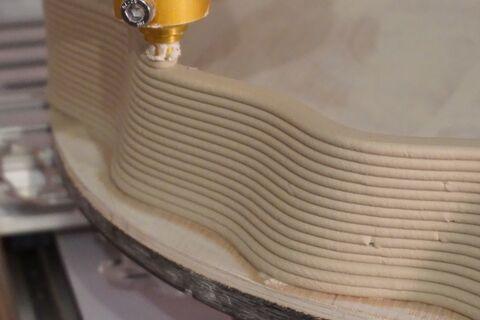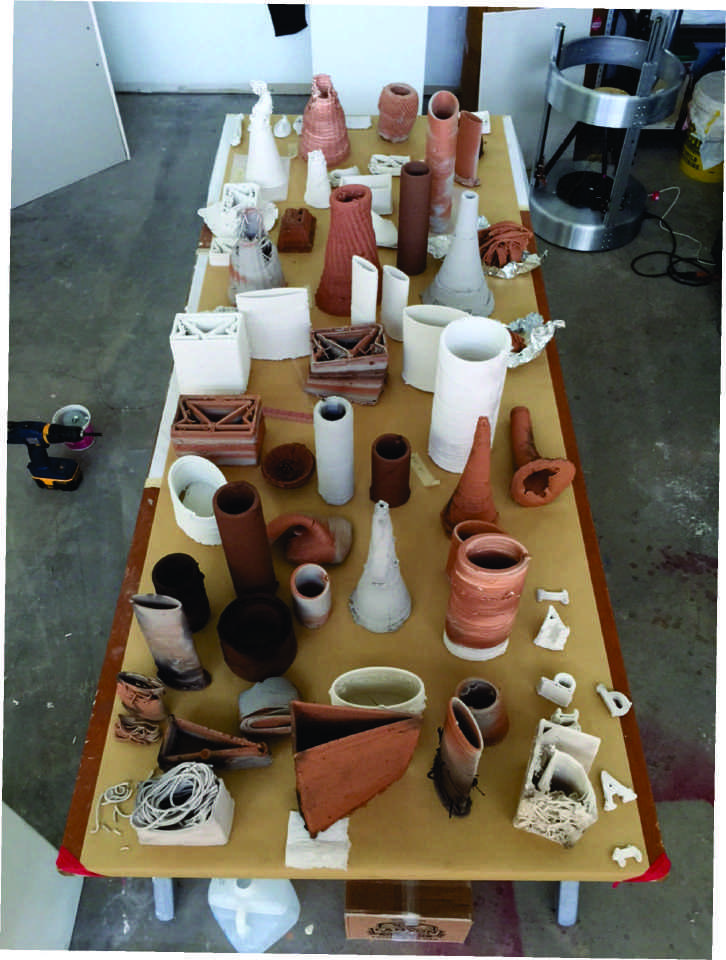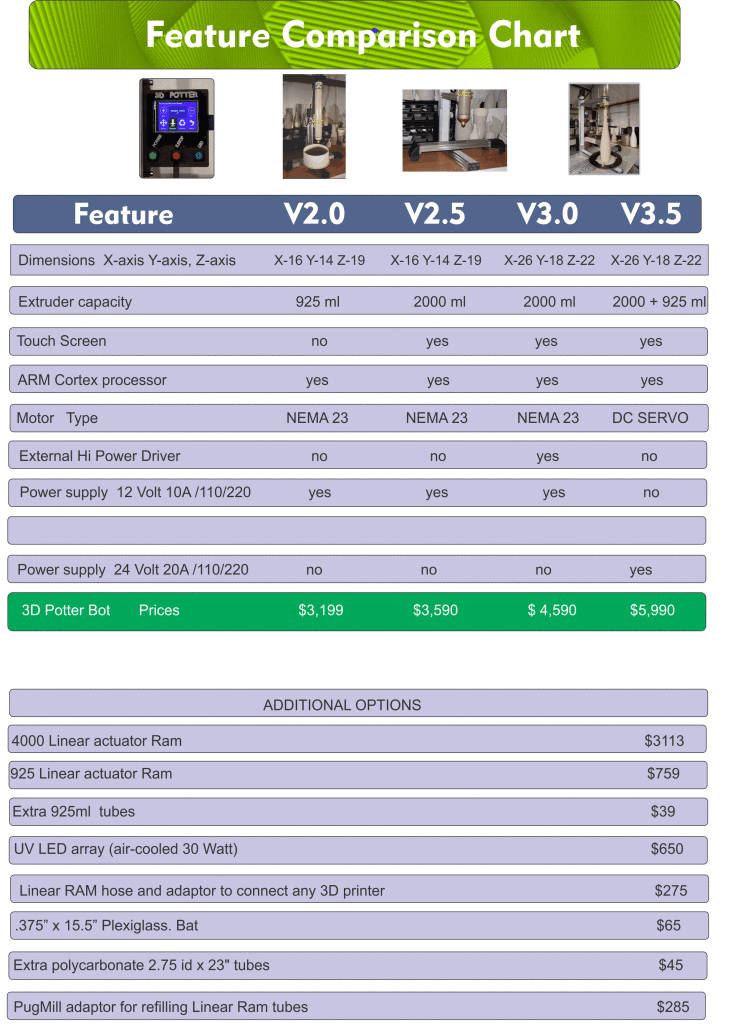DeltaBots Rolls Out Four New 3D PotterBot Printers: Greater Volume, Complex Touch Screen, Standalone Printing
 As the world of 3D printing becomes one that is suddenly ripe with a plethora of machines offering countless features, and a multitude of materials aside from those of the basic ABS and PLA, just about anything can be fabricated. If you Google it, you’ll probably see it’s been 3D printed–or someone is currently working on the concept. There are numerous alternative materials that we know are out there–and have been for quite some time–but we don’t hear of a lot. One of those is ceramics.
As the world of 3D printing becomes one that is suddenly ripe with a plethora of machines offering countless features, and a multitude of materials aside from those of the basic ABS and PLA, just about anything can be fabricated. If you Google it, you’ll probably see it’s been 3D printed–or someone is currently working on the concept. There are numerous alternative materials that we know are out there–and have been for quite some time–but we don’t hear of a lot. One of those is ceramics.
Offering an incredible new tool to those manufacturing pottery and ceramics, we’ve been following DeltaBots since they released their 3D PotterBot printer much earlier in the year. And although there are certainly many tools aiding in the formation of pottery already, by automation and for artisanal manual production, the 3D printed version is nothing short of fascinating to watch. The PotterBot–able to print in large volume–is unique in every way, from its delta-style framework to its stationary extrusion system to its unusual and elegant aethestics.
 And now, the Florida-based company has taken a break from filling orders of their original machine to create and release four new versions of the PotterBot, meant to integrate all they’ve learned while designing the original inverted Delta as well as using customer feedback. They’ve begun with a completely clean design, which the team emphasizes is meant to maximize the build envelope.
And now, the Florida-based company has taken a break from filling orders of their original machine to create and release four new versions of the PotterBot, meant to integrate all they’ve learned while designing the original inverted Delta as well as using customer feedback. They’ve begun with a completely clean design, which the team emphasizes is meant to maximize the build envelope.
Using the Cartesian configuration but still retaining all the unique and defining features of the first PotterBot, the innovative 3D printing manufacturer has produced the following new releases:
- V2.0 – a basic 3D printer offering the advanced ARM processor board without touch screen, and has a smaller capacity 925 ml extruder. This PotterBot is better for those who are planning to use their 3D printer while connected to a computer and is good for producing smaller batch of ceramics–or even food.
- V2.5 – offers an even more advanced ARM processor controller board with integrated multifunction touch screen and the 2000 ml RAM direct extruder. Meant for learning institutions, it also comes equipped with standard NEMA stepper motors. This model and all above this level allow for standalone printing and full control from the touch screen via SD card.
- V3.0 – offers extra size and a larger build envelope, along with all of the features of the V2.5, including the ability to produce between five and eight ‘vessels.’
- V3.5 – the top of the line printer, also offering an integrated Servo system delivering faster and quieter performance.
 All versions feature traveling X and Y axes while lifting the stationary extruder on the Z axis. The direct nozzle RAM extruder allows for a great advantage over hose configurations with high pressure air assist, and these are only 3D printers with direct linear RAM that can print with full body clay–the only way to accommodate making larger ceramic pieces.
All versions feature traveling X and Y axes while lifting the stationary extruder on the Z axis. The direct nozzle RAM extruder allows for a great advantage over hose configurations with high pressure air assist, and these are only 3D printers with direct linear RAM that can print with full body clay–the only way to accommodate making larger ceramic pieces.
“Our unique design utilizes traveling X & Y axes with stationary Z axis extruder. But what is really innovative is how the X-axis is allowed to travel freely on top of any flat surface it is positioned on. This means a compact, easy to store and easy to ship design with no large bulky box for structural support. The traveling X-axis is completely supported by our new mechanism at the end of each X-axis rail,” said DeltaBots president Danny Defelici.
Printing with ceramics is a much different exercise, and the PotterBot, as DeltaBots points out, is not just another 3D printer. Inspired by the design of CNC milling machines and routers, these 3D printers offer superior rigidity to carry the heavy loads expected of them. This is achieved through a sturdy structure, contained with high precision USA made ACME lead screws with a robust aluminum C-Beam channel.
“By extruding directly from the bottom of the nozzle on the bottom of the extruder we are able to achieve exceptional layer height consistency throughout the entire print,” states the DeltaBots team. “With our 2000 ml direct extrusion RAM, there’s no need for complicated hoses and huge air compressor. Everything is contained within a small package.”
Regardless of the model chosen, these are sturdy machines offering great durability and convenience to users, who will be able to go farther with pottery and ceramics, innovating bigger and better in the classroom than ever before. Let us know your thoughts on these new printers in the Potterbot forum thread on 3DPB.com.
Subscribe to Our Email Newsletter
Stay up-to-date on all the latest news from the 3D printing industry and receive information and offers from third party vendors.
You May Also Like
3D Printing Unpeeled: New Arkema Material for HP, Saddle and Macro MEMS
A new Arkema material for MJF is said to reduce costs per part by up to 25% and have an 85% reusability ratio. HP 3D HR PA 12 S has been...
3D Printing News Briefs, January 20, 2024: FDM, LPBF, Underwater 3D Printer, Racing, & More
We’re starting off with a process certification in today’s 3D Printing News Briefs, and then moving on to research about solute trapping, laser powder bed fusion, and then moving on...
3D Printing Webinar and Event Roundup: December 3, 2023
We’ve got plenty of events and webinars coming up for you this week! Quickparts is having a Manufacturing Roadshow, America Makes is holding a Member Town Hall, Stratafest makes two...
Formnext 2023 Day Three: Slam Dunk
I’m high—high on trade show. I’ve met numerous new faces and reconnected with old friends, creating an absolutely wonderful atmosphere. The excitement is palpable over several emerging developments. The high...


































